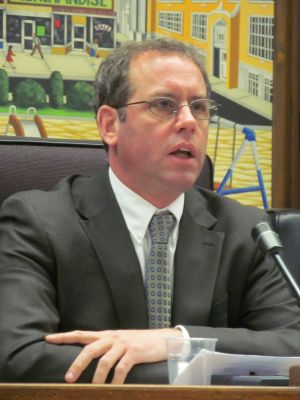Village of New Hyde Park officials are planning to discuss plans for a third Long Island Rail Road track this week with two Metropolitan Transportation Authority leaders and a representative of Gov. Andrew Cuomo, Mayor Robert Lofaro said Tuesday.
Lofaro and village Deputy Mayor Lawrence Montreuil will likely meet Friday with MTA Chairman Thomas Prendergast, LIRR President Patrick Nowakowski and a Cuomo aide at the MTA’s Manhattan offices to discuss some of the concerns the village has voiced, Lofaro said.
“Maybe our message is being heard,” he said. “I’ll give them the benefit of saying maybe this is going to be a positive meeting, that they have some ideas they want to kick around on the elimination of the grade crossings in a manner acceptable to the village.”
Gov. Andrew Cuomo wants to meet with mayors along the 9.8-mile stretch of the LIRR’s Main Line between Floral Park and Hicksville to advocate for his plan for a third track, Lofaro said.
Lofaro is open to talking with any proponents of the plan Cuomo announced in January, as long as the conversation focuses on the potential benefits to and impact on New Hyde Park, he said at the Feb. 16 Village Board meeting.
In a recent meeting, Lofaro and village representatives told Nowakowski and other MTA officials the village will remain opposed to the $1 billion to $1.5 billion project unless specific plans, which have yet to emerge, eliminate the village’s three street-level railroad crossings at New Hyde Park Road, Covert Avenue and South 12th Street, Lofaro said Feb. 2.
In a statement Wednesday, Cuomo transportation spokeswoman Beth DeFalco said representatives for Cuomo and the MTA have already begun meeting with local officials and “will continue to meet and work closely with officials and communities throughout the life of the project.”
MTA LIRR spokesman Salvatore Arena has said the project will involve an environmental review that will evaluate the elimination of all seven grade crossings along the corridor and include “significant community outreach.”
DeFalco said last week the third track outreach will “set a new standard on Long Island” and include door-to-door discussions and a website with a direct link to the project’s planners.
“The comments and opinions of all stakeholders will be taken into account as the LIRR engages in extensive outreach with a focus on community involvement and homeowner protection,” she said Wednesday.
The outreach to villages has so far been similar to the MTA’s efforts in the mid-2000s, when the third track was last proposed and ultimately defeated, Lofaro said.
“I think they’re doing the right things,” he said. They’re communicating, and that’s because we need to know what they want to do, and they’re giving us an opportunity to communicate as well.”
Lofaro said mayors and community leaders from villages along the Main Line had a conference call Feb. 12 with state Sen. Jack Martins (R-Mineola), who opposed the earlier plans as Mineola’s mayor.
They plan to have regular talks to keep each other informed as they meet individually with officials and learn more about the third track proposal, Lofaro said.
While transit officials have not unveiled specific plans for the new project, DeFalco has said it is “radically different” and will have “increased community benefits.”
It will be built entirely within the LIRR’s right of way where possible and will require about a quarter of the property acquisitions the old plan required, minimizing impacts on surrounding communities, MTA officials have said.
Proponents argue a third track would ease east- and westbound commutes and spur economic growth on Long Island.
A 2014 study by the Rauch Foundation Long Island Index found over 10 years, it would add 14,000 jobs, 35,000 new residents, $3 billion in personal income, $5.6 billion to Long Island’s gross regional product, $40 million in sales tax revenue and $103 million in property tax revenue.
But villages along the Main Line, including New Hyde Park, Floral Park and Mineola, have said they still have concerns based on the old plan.
Construction and property acquisitions would disrupt businesses and residences, eliminate parking spaces and worsen traffic at grade crossings, opponents have said, and result in increased noise from additional train traffic.
New Hyde Park is unlikely to change its mind unless new plans address the village’s sustained concerns, Lofaro said.



